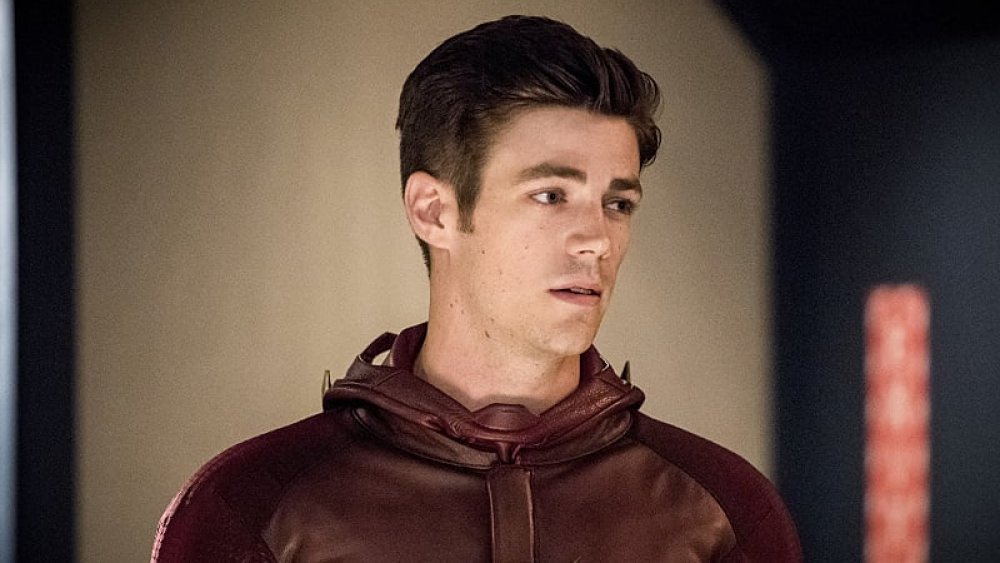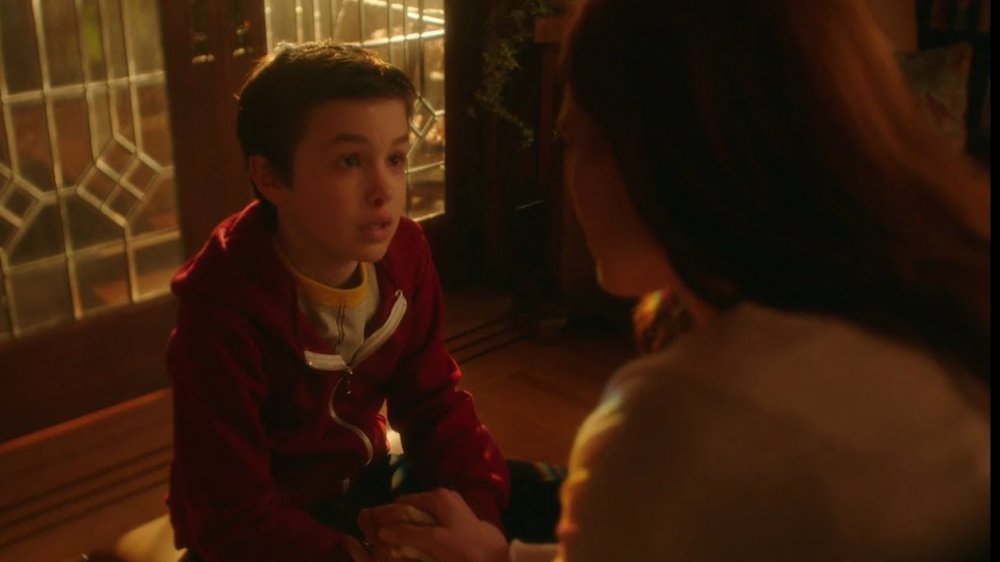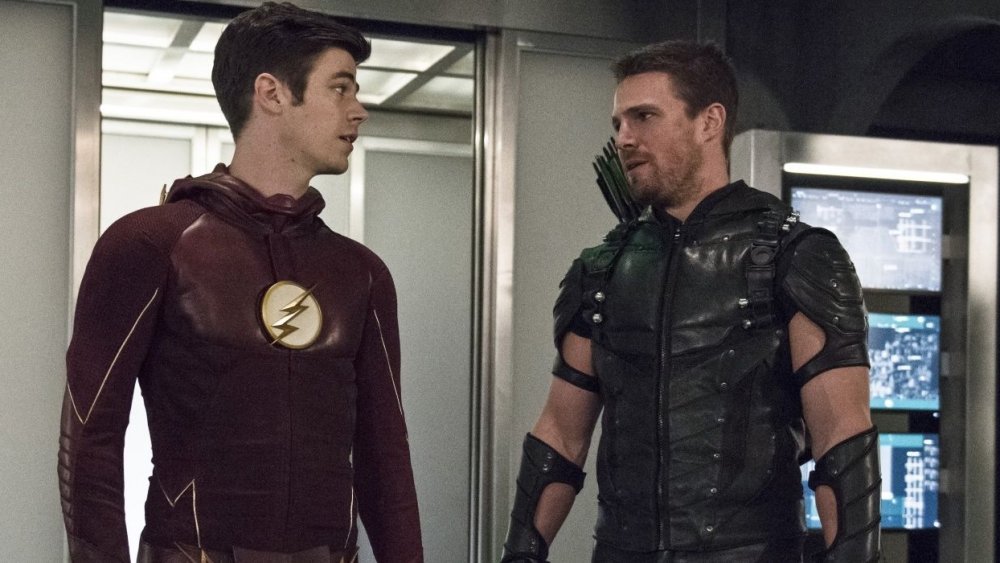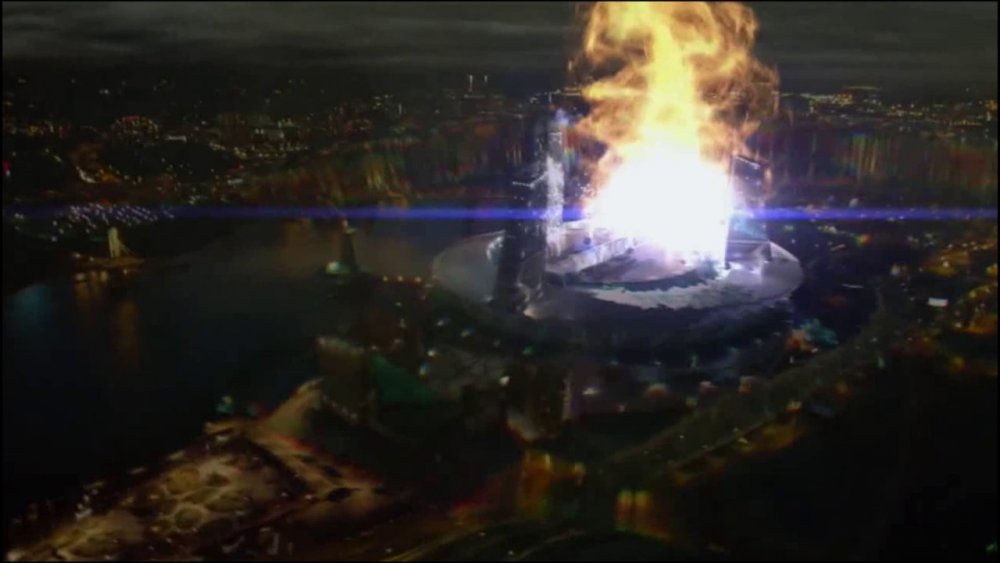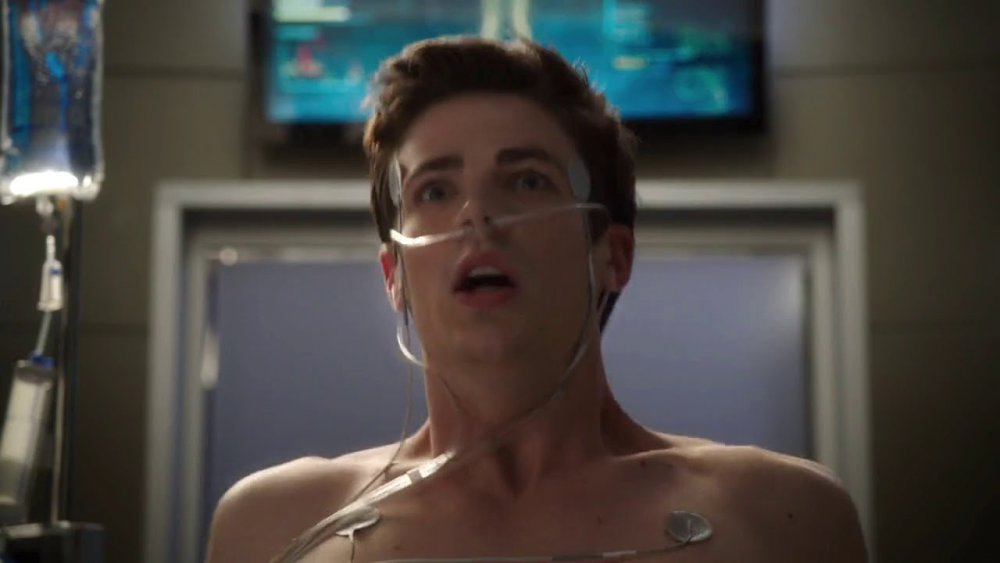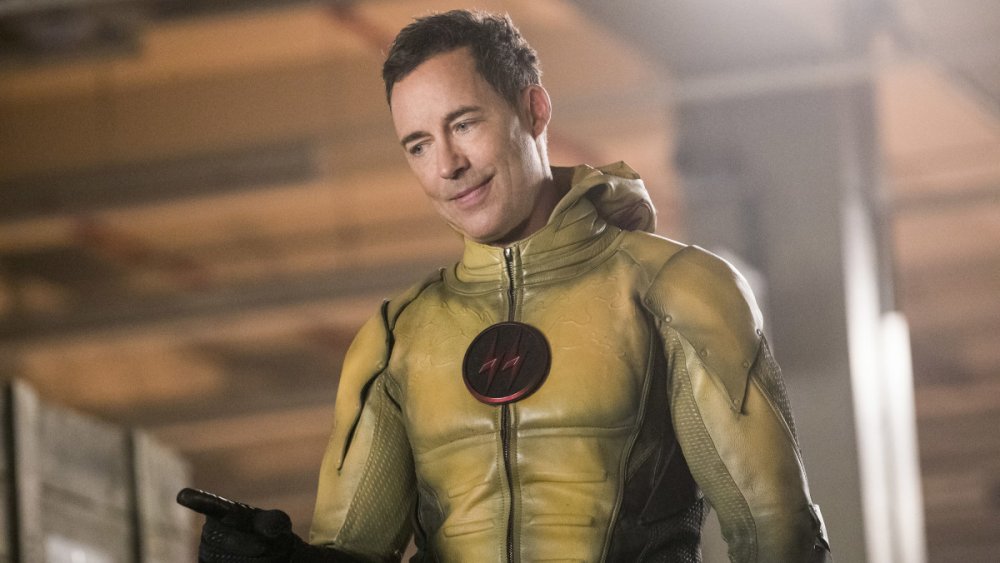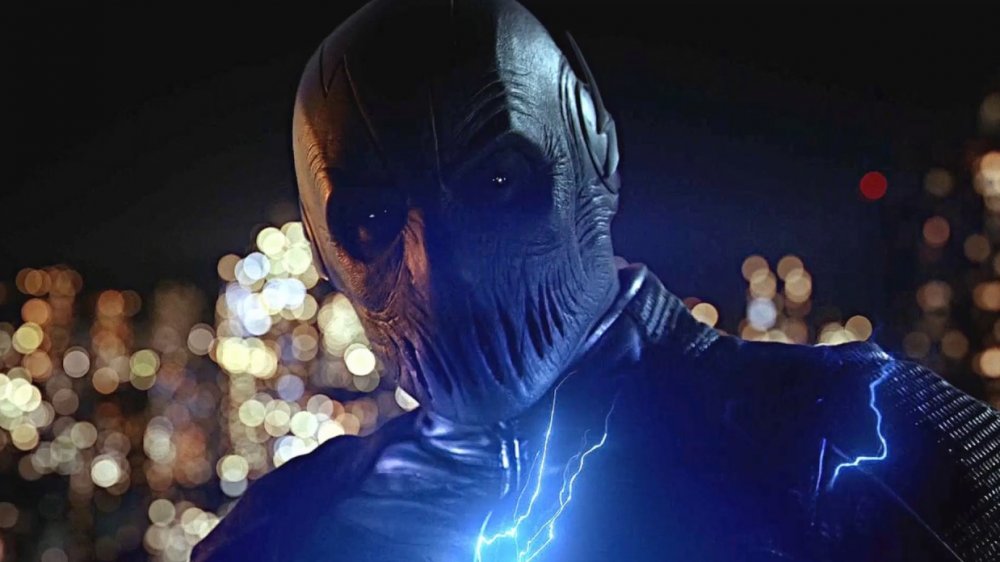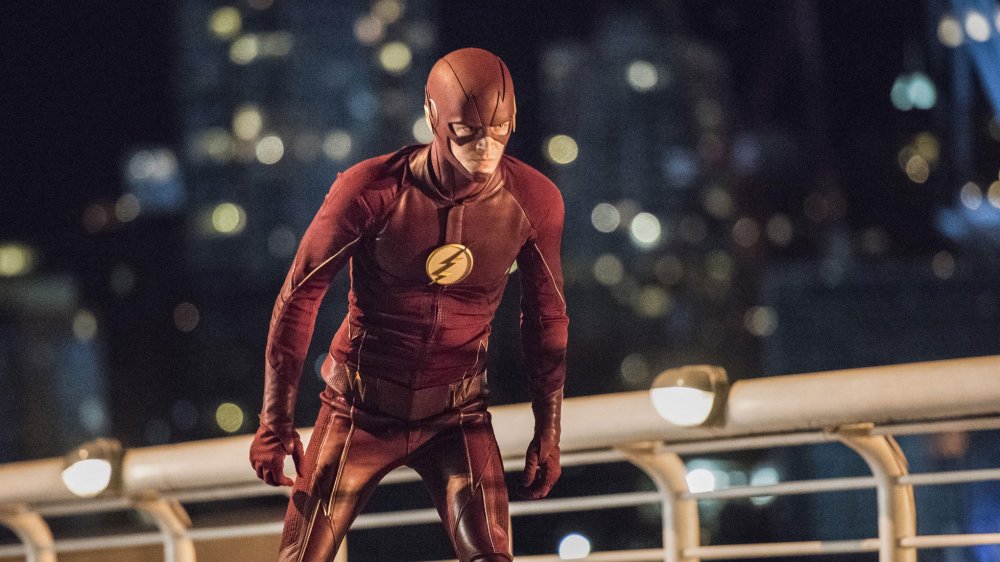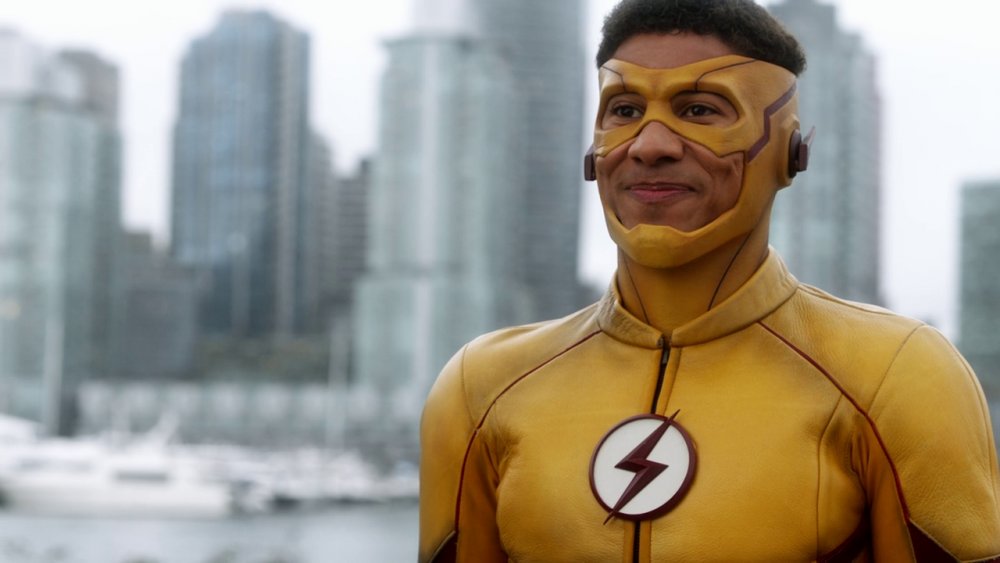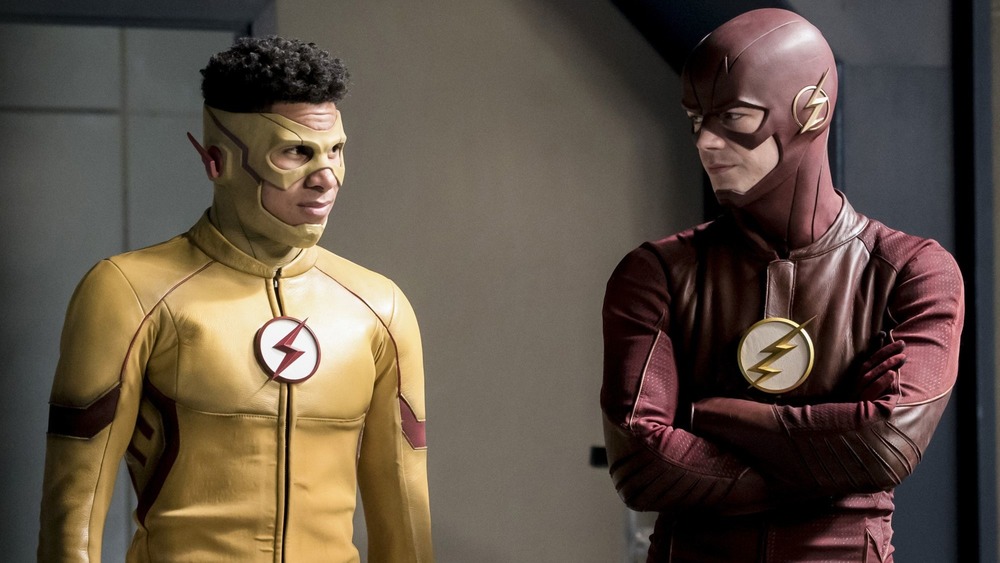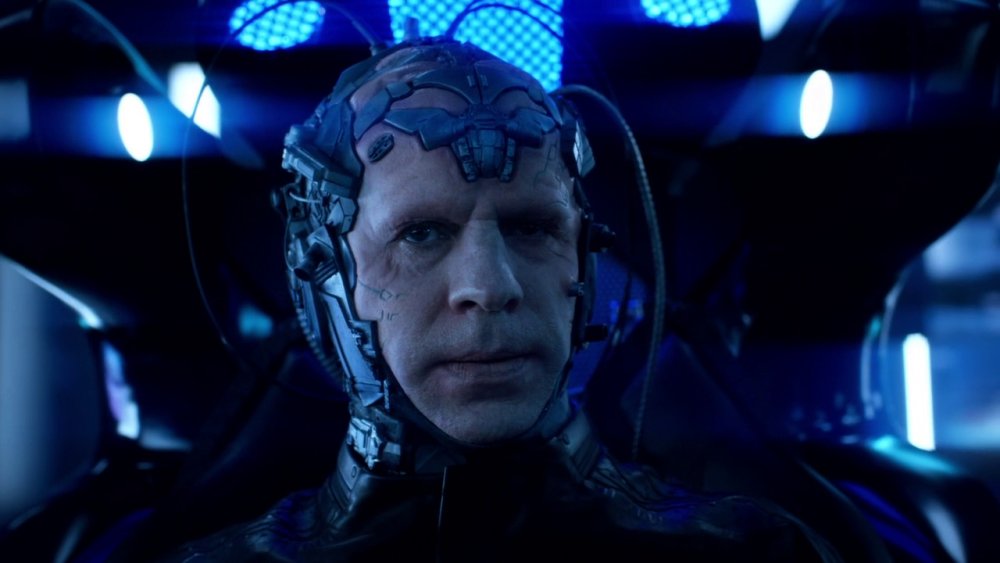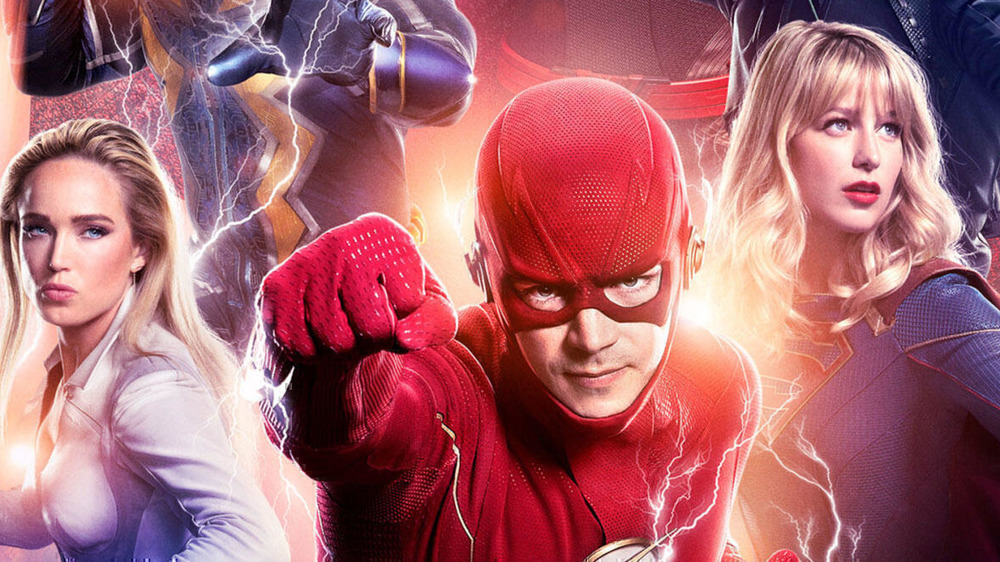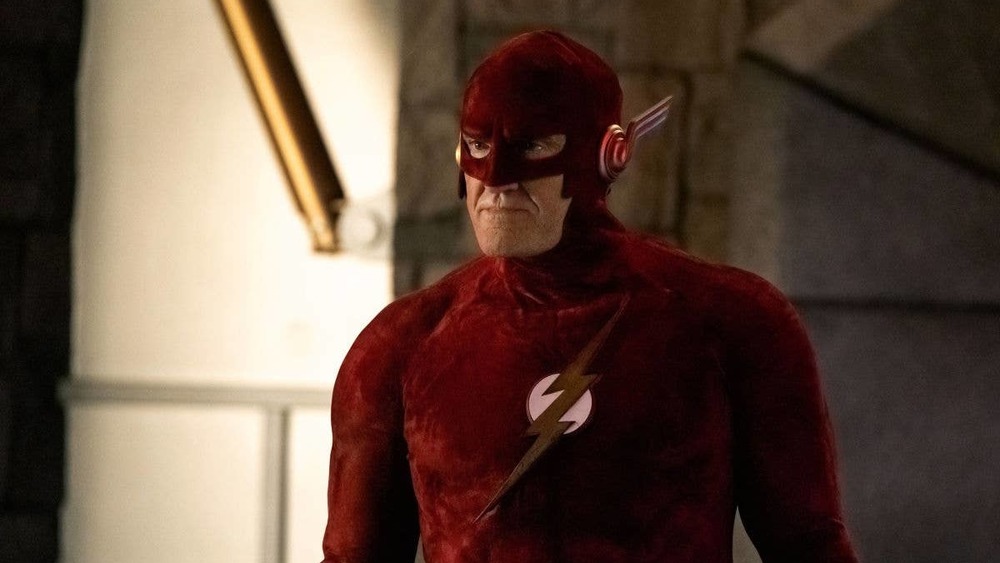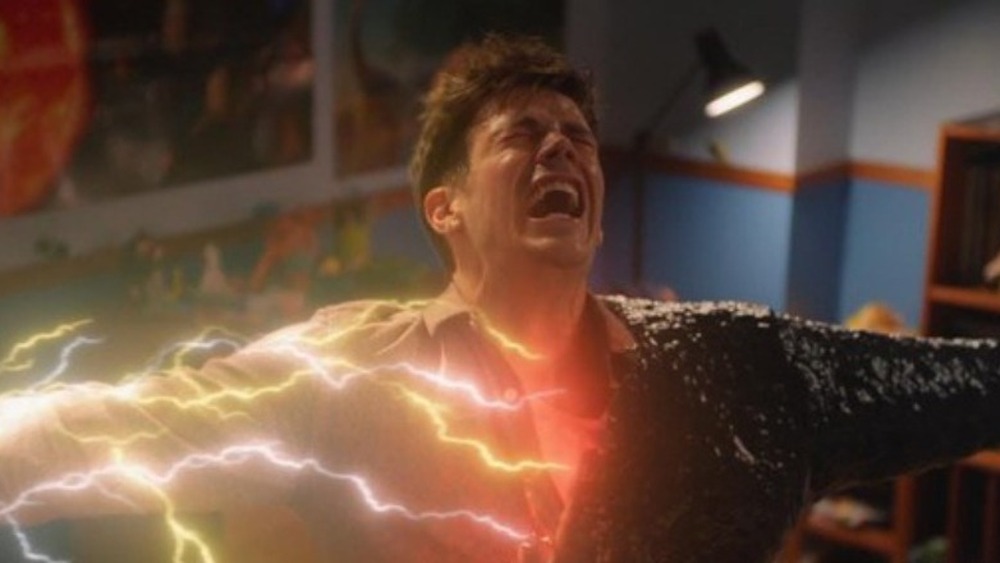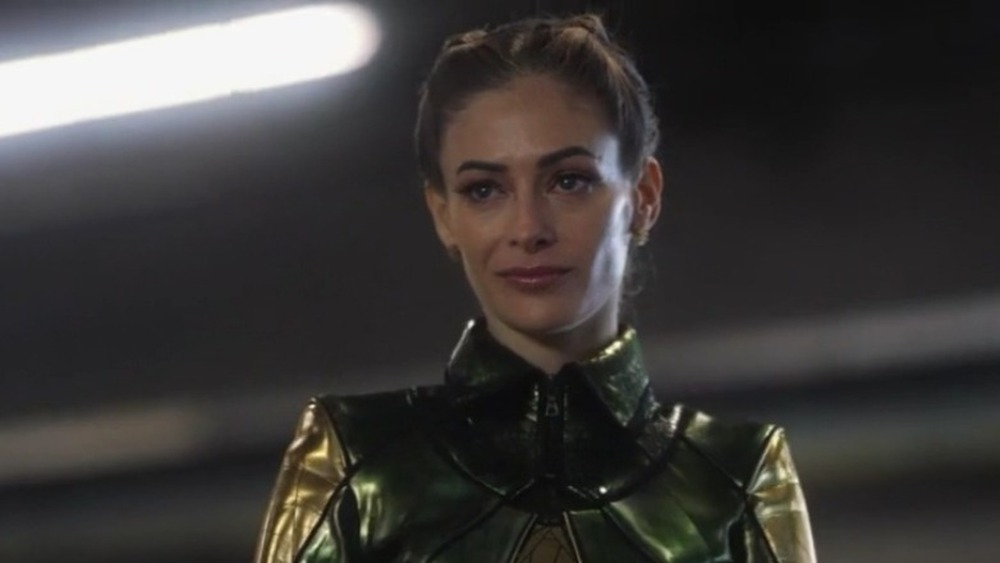Barry Allen's Entire Arrowverse Backstory Explained
The first twenty years of this century have been defined by superhero stories. But before the MCU colonized the silver screen, there were the comics that started it all. Unlike cinematic universes, comics don't progress in a steady, linear fashion towards a well-plotted climax. Comic books are messy, chucking characters, power sets, and even entire universes out the window when they want a fresh start. If you want to see this anything-goes approach applied to live action superhero storytelling, you can't look to the movies — they're too expensive, too edited, and too high profile. For that spirit, you need to turn to the television.
The Arrowverse carries on the spirit of comics with particular skill. It's a tangle of alternate timelines, knotty character motivations, and multiverse-destroying plot points — and that's precisely why we love it. But if that intimidates you, fear not: There are many entry points into the Arrowverse. Barry Allen, the Flash himself, is one of the best, and we're here to explain his Arrowverse story, one event at a time.
A formative trauma
By all accounts, Barry Allen had an ideal childhood. His memories of it are filled with watching old musicals with his mother, Nora, and traveling to museums with his father, Henry. That would all change on March 18, 2000, when Nora was killed by an inexplicable phenomenon. Barry, startled by a commotion downstairs, discovered his mother surrounded by strange streaks of red and yellow lightning. He briefly made out a man in yellow, tearing through the room at impossible speeds. When his father told him to run, Barry took off ... and suddenly found himself several blocks away.
By the time Barry made it back to his home, his father was being dragged away in handcuffs and his mother was dead. Barry went to live with the family of his closest friend, where his budding interest in science became a full-blown obsession. Though he couldn't prove his father was innocent on his own, he knew there had to be a way to exonerate him with concrete evidence. He dedicated the rest of his schooling to studying physics, chemistry, and criminology.
A bit of a fanboy
Barry inhabits the Arrowverse, the CW's live-action superhero canon. This shared universe began with Arrow, a 2012 series centered around Oliver Queen, AKA Green Arrow. Barry's beginning in the Arrowverse arrives in the second season Arrow episode "The Scientist."
By this point in his life, Barry Allen has become a criminologist still deeply troubled by his mother's death. He travels to Star City in the hopes of meeting his idol, Green Arrow. He lies his way onto his team, pretending to be working a case on behalf of Central City's police department.
While there, he impresses Green Arrow by correctly figuring out a lot of information about the way the masked vigilante operates. Barry's story eventually falls apart, however, forcing him to reveal that he's looking to work on supernatural cases. If he can prove a case to be the work of things beyond our current comprehension, he believes he'll be able to exonerate his father and solve his mother's murder. After solving a cold case and saving Green Arrow's life, Allen hops a train back to Central City.
From the top
After his adventures on Arrow, Barry Allen's standalone story truly begins. On that train back to Central City, he meets fellow physicist Martin Stein, and the two quickly bond over their shared interest in a particle accelerator project being run out of S.T.A.R. Labs. Even as Barry carries on his work as a crime scene investigator, he can't shake the idea of the work being done by S.T.A.R. He goes to the unveiling of the accelerator and continues to watch its progress even after the crowds clear.
Barry's fixation is understandable — the particle accelerator promises to reveal undiscovered realms of science. Since he has dedicated his life to solving the mystery of his mother's death, any grand expansion of scientific understanding is of interest to Barry. He didn't need to be enamored with the accelerator for what came next, however: The massive machine explodes, sending a shockwave across the city.
Barry is struck by lightning through a nearby window and falls into a coma. When he is hospitalized, the staff notice all sorts of strange phenomena, including a constant flat-lining that has no ill effect upon him. The mind behind S.T.A.R. Labs' accelerator, Dr. Harrison Wells, realizes that Barry's heart is beating too fast to register on hospital equipment. When it becomes clear that they are dealing with something entirely out of the ordinary, a comatose Barry is moved to S.T.A.R. for closer observation.
Getting the hang of things
Barry wakes after nine comatose months, and quickly discovers that something is wrong with him. He heals from injuries rapidly, and begins experiencing time dilation. Moments slow down as his perception heightens to impossible speed. On a run, he realizes that he's been given the gift of super-speed, and sets about testing the limits of his new powers. In the course of figuring out what's going on with him, Barry realizes that he's not alone in possessing superpowers. In the wake of the accelerator's explosion, all sorts of Central City criminals have developed extraordinary abilities.
Barry comes to grips with his powers, and begins to solve crimes and foil villains in Central City as the Flash. As he uncovers more and more about the fallout of the explosion, he begins to suspect that Dr. Harrison Wells is not who he seems. In conversation with his S.T.A.R. Labs' team and his friends at the CCPD like Eddie Thawne, Barry makes it clear that he's getting closer to solving the mystery of his mother's death.
Nefarious plots
Everything comes to a head when Barry's adoptive father Joe West and his S.T.A.R. Labs' associate Cisco Ramon uncover Harrison Wells' body. Barry's crew heads to the lab, and discover "Harrison Wells" to be a false persona. They uncover a secret room containing the yellow costume of the man Barry saw the night his mother died, as well as a news clipping from 2024.
The team works out that Wells is someone from the future: Eobard Thawne, a villain known as Reverse-Flash, who regularly battles the Flash in his own time. He goes back to Barry's timeline to kill him as a child, but is thwarted by a future version of the Flash, and ends up stuck in the past. He took on Well's identity to guide the lab toward making the particle accelerator. The explosion was an intentional event to create the Flash, so that he might harness Barry's abilities to return to his own time. After several fights between Eobard and Barry, Eddie Thawne realizes that he can stop Eobard from ever existing.
Since Eobard is a direct descendant of Eddie, Eddie opts to kill himself. During a fight between the Flash and the Eobard, Eddie shoots himself with his service pistol and causes Eobard to wink out of existence. As a parting shot, Eobard tells Barry that he's controlled his entire life and that he would not exist without him.
An unlikely foe
The second season of The Flash gives Barry a new nemesis. Like Eobard, he disguises himself as a friend, despite actually being from another time and place. He is Hunter Zolomon, and he has traveled to Barry's dimension through a rift created by Eobard's disappearance. Zolomon comes from another Earth, where he is a serial killer obsessed with making himself fast. He has traveled to Barry's Earth in order to harvest his speed energy.
He disguises himself as Jay Garrick, a Flash from yet another timeline, and befriends Barry. All the while, he acts as the villainous Zoom, giving Barry a reason to hone his powers — a process Jay helps with, naturally. Zolomon manages to call forth a time remnant of himself, and lets Barry see it getting killed. Believing that his mentor has been murdered, Barry trains all the harder.
Eventually, the S.T.A.R. Labs team learns of Zolomon's true identity, leading to a showdown between Zoom and the Flash. He kills Flash's father, Henry, and attempts to destroy the entire multiverse, but Barry outsmarts him using the same time remnant trick Zoom used on him. Time Wraiths pull Zoom out of the universe and trap him within the Speed Force.
Flashpoint
Barry's entire life has been driven up to this point by the dream of obtaining justice for his father. With his dad suddenly dead, Barry is left completely unmoored. He simply cannot tolerate any further suffering. He has lived his life in pursuit of one goal — righting the wrong that has kept his living parent separated from him — and that goal has been snatched away. In spite of all he's learned about timeline meddling being dangerous, Barry runs back to the night his mother died and saves her life. He then beats Reverse-Flash unconscious and uses a dampening cage to trap him in a prison in 2016.
In this newly altered timeline, Barry, surprisingly, is still an investigator, living a happy life with his family fully intact and pursuing a relationship with his childhood friend, Iris. But little by little, his old memories are beginning to disappear.
Making things right
Despite the seeming peace of this reality, all is not well. Barry's treks around Central City make him realize that his friends are suffering. Iris' younger brother Wally West becomes the Flash in Barry's absence, but with nowhere near the same level of support. Without the backing of a team like S.T.A.R. Labs, Wally runs himself ragged fighting a villain called the Rival. Barry agrees to help Wally where he can, but eventually sees that it is no use.
Barry's lifelong friend and love interest is in danger of being murdered in the new Flashpoint universe, proving that he can't expect to have a perfect life in any timeline. After Wally is seriously hurt while fighting, Barry is faced with a terrible choice. He can reset the timeline by freeing Reverse-Flash to kill his mother, or he can allow his friends to continue suffering in the new world he has wrought. Barry makes the choice you'd expect of a hero, taking Reverse-Flash back to the past. He accepts that injustice to prevent a greater one.
Ch-ch-ch-ch-changes
Watching The Flash can sometimes feel like trying to keep track of where pebbles were dropped into a lake. As you attempt to fix your eyes on the origin point of one set of ripples, more rocks are tossed in to create concentric circles of their own. Eventually off of this becomes a mishmash of interconnected microwaves that you have to throw your hands up at, knowing little more than the fact that you're looking at a lake. All that is to say, altering the timeline in Flashpoint was not without consequences for Barry Allen and his friends.
The alterations shifts the lives of many main characters and even brings forth a few people previously unknown to Team Flash. The timeline tinkering directly leads to the rise of Caitlin Snow as the villain Killer Frost. It also drives a deep wedge between Barry and Cisco Ramon. Ramon resents that Barry was able to alter so much of time, but refused to use his powers to travel back and change the conditions so that his brother Dante might live. Dante was alive in the pre-Flashpoint timeline, but there's no guarantee that he would be in any post-Flashpoint timeline Allen might help create.
Savitar and Wally West
Season three of The Flash had perhaps the most-confusing villain in the history of the series. The Savitar was a time remnant, a sort of speedster super glue that works to stick together the space-time continuum whenever a Speed Force user smashes it to bits with all their time travel. They are little fixes that come to exist in order to keep the timeline on track. The Savitar exists in a paradoxical time loop. It goes like this:
Savitar kills Iris West, causing Barry Allen to trample all over time to defeat him. This creates several time remnants of Barry Allen all throughout history. All of these remnants save one are killed by the villain Savitar, and the one who lives is left behind in a sort of Speed Force purgatory, slowly going insane. Eventually the option comes for the remnant to free himself from this prison and he does, calling himself the Savitar as he travels through time. To ensure that he gets created in the first place, he goes to the date of Iris West's death and kills her. Simple, right?
Throughout the season-long fight with Savitar, Barry helps train Wally West, a.k.a. Kid Flash. The newly empowered speedster is impatient and wants to begin helping Team Flash as quickly as possible. After several harrowing fights (and one absorption into the Speed Force), Kid Flash mellows a bit and begins to absorb the lessons being taught by Barry. When the time comes for Barry Allen to sacrifice himself to the Speed Force to save Jay Garrick, Wally is ready to take on the mantle of the Flash in his brief absence.
Barry and Iris tie the knot
Superhero weddings can't go off without some kind of super-flavored complication, and the marriage of Barry Allen and Iris West proves no exception. The couple decides to finally take their marriage vows during the fourth season of The Flash, but the beginning of the ceremony actually takes place in a season 3 Supergirl episode. Friends of the bride and groom from Supergirl, Arrow, and Legends of Tomorrow are at the proceedings when it's interrupted by an assault from the Nazi villains of Earth-X — an alternate Earth where the Axis Powers won World War II and subsequently conquered the globe. The attack heralds the fourth of the Arrowverse's annual crossover events, "Crisis on Earth-X."
The leaders of the "New Reichsmen" include evil Earth-X counterparts to the Arrowverse heroes, like the Führer Oliver Queen, a.k.a. Dark Arrow, and his wife Overgirl, Earth-X's answer to Supergirl. During the crossover, Barry and many of the other Arrowverse heroes are captured and placed in Earth-X's concentration camps. With the help of the Earth-X native team the Freedom Fighters, Barry and the other heroes are rescued. Tragically, Martin Stein is mortally wounded while trying to open a portal back to Earth-1 and later dies.
After the heroes drive back an Earth-X assault on Earth-1's Central City, the wedding of Barry and Iris resumes, this time with John Diggle officiating. Thankfully, this time it finishes with a lack of supervillain attacks.
A villain's villain
The Flash's fourth season introduces a slew of new baddies, all created by a single mastermind. When Barry confronts this head honcho, he finds a dying man in a wheelchair named Clifford DeVoe. He underestimates the man, and Barry is framed for his murder.
While Barry sits in prison, DeVoe takes over the body of one of his creations. The Flash nearly gets sold to a black market dealer in superpowers named Amunet Black. A shapeshifter created by DeVoe clears Barry's name. DeVoe continues to hop around the bodies of those he created, while the Flash and his friends set about warning his remaining progeny.
DeVoe reveals his plan: He hopes to use a series of satellites to permanently rewire every human on Earth, a plot he calls "The Enlightenment." Barry teams up with Amunet Black, and they destroy DeVoe's main satellite with a bomb procured via their connection to illegal markets.
DeVoe had planned for that eventuality, however. His satellites begin falling to Earth, targeting Central City. The Flash very nearly fails to stop all of the falling satellites, until a new Speed Force user named Nora appears. She helps to stop the destruction, but tells the Flash he just made a terrible mistake.
Timelines in chaos
Nora tells Barry and Iris that she is their daughter from the future. She came back in time to stop a new villain named Cicada, who is an unstoppable force in her own timeline. It is revealed throughout the season, as Barry and his allies attempt to mitigate the havoc being wreaked on the timeline, that Nora is regularly traveling back into the future to work with the villainous Eobard Thawne.
The bad guy, it seems, has earned Nora's trust while imprisoned, and he's manipulated her into traveling to the past to set in motion events that might set him free. A magical dagger that holds Thawne captive in a prison of the future is destroyed in the past, allowing him to break out of prison and reappear in the main timeline. The timeline-shifting ends in Nora winking out of existence, leaving Barry and Iris without a daughter.
Crisis on Infinite Earths
A lot of DC lore has come to the screen over the last few decades. We've seen takes on everything from Harley Quinn's superteam to Alan Moore's beloved run on Swamp Thing. But until season 6 of The Flash, no one had attempted to take on Crisis on Infinite Earths.
The landmark crossover comics event from the 1980s told an epic tale while serving a functional purpose. As a villain known as the Anti-Monitor threatened to wipe out all existence on the page, the event gave DC a clean slate by wiping out the myriad parallel universes that had appeared to account for decades of continuity problems. In creating a single, unified DC universe, countless iterations of famous characters were killed. In the comics, this included Barry Allen, who sacrificed himself in a move that allowed other heroes to defeat the Anti-Monitor.
Television's Arrowverse saw a similarly cataclysmic restart in season 6 of The Flash (as well as concurrent seasons of all its associated shows) — and viewers who only knew Barry through Grant Gustin's portrayal finally came to understand the terms "pre-Crisis" and "post-Crisis."
A near-death experience
Season 6 of The Flash begins with Barry learning that the Crisis is coming sooner than Team Flash had hoped. It becomes clear that the Flash will die during the multiverse-wide shakeup, and Barry begins preparing all of his friends, family and fellow crimefighters for a world without him.
At the same time, a villain called Bloodwork threatens Central City. Bloodwork is attempting to find a cure for a deadly disease that runs in his family, but the treatment he found turned him monstrous and filled him with a need for the blood of others to maintain an eternal life. At some point, he realizes that his blood can effectively control others if it gets into their system, and he sets out to create an army of "Blood Brothers." Bloodwork's quest for never-ending life and Barry accepting his fate are played as mirrors of each other throughout the season, even as Allen is infected and controlled by the villain. Bloodwork's master plan to infect the entire city ultimately backfires, and all of his minions are returned to normal.
In their confrontation with the Anti-Monitor, another Flash from a different part of the multiverse (who is also named Barry Allen) ends up sacrificing himself to save existence. Barry Allen does die, it turns out — just not the one who leads The Flash. The season closes with Barry attempting to carry on in a newly created multiverse that only he and a few other metahumans know is not the world as it was. His actions during the Crisis also destroy the Speed Force, the borderline mystical reserve of energy from which speedsters pull their powers.
The death and rebirth of the Speed Force
While the heroes' efforts during Crisis on Infinite Earths restore the multiverse, that victory comes at some high costs, including the very thing that gives Barry Allen his powers. In season 6's "Death of the Speed Force," as the title implies, Barry and Wally learn the Speed Force is in trouble. Confronting the Speed Force's human manifestation, Barry learns that when Oliver Queen — as the Spectre — used his power to get Barry back into the Speed Force during Crisis, it contaminated things. In spite of Barry's best efforts, the Speed Force seemingly dies, leaving Barry and Wally only weeks left of residual speedster powers.
With the help of Nora West-Allen's diary and through much trial and error, Team Flash is able to build an Artificial Speed Force that Barry can access, but once again the cost is too high. In the season 7 premiere, Nash Wells sacrifices himself to power the ASF with his multiversal energy. In the following episode, Team Flash learns the ASF is causing Barry's thinking to gain as much speed as his body, with catastrophic consequences to his personality. Once Barry realizes what's happening to him, he disables the new source of his powers.
But all is not lost. In "Mother," with the help of the re-emerged Harrison Wells, the residual Speed Force within Iris and the ASF, Team Flash succeeds in essentially rebooting the Speed Force — thus giving Barry back his powers.
Mirror Monarch traumatizes Central City
On the fateful night of the S.T.A.R. Labs particle accelerator explosion, Eva McCulloch — CEO of McCulloch Enterprises — is killed as she's thrown into a mirror. The dark matter creates a mirror universe duplicate of Eva with all of her memories stuck in the Mirrorverse — a universe that reflects Earth-Prime but is governed by different physical laws. In season 6, Eva tricks Iris into allowing herself to be pulled into the Mirrorverse, while a Mirror duplicate of Iris replaces her on Earth-Prime with Barry and Team Flash blind to it all. After likewise capturing and creating duplicates of Singh and Cisco's girlfriend Kamilla, McCulloch finally escapes to Earth-Prime.
Eva — who calls herself Mirror Monarch — plans to take over the globe by replacing everyone with their mirror counterparts, and she has Team Flash at a huge disadvantage. While she's getting up to all sorts of no good, Barry is dealing with what is initially believed to be the death of the Speed Force. Once it's restored, however, Barry is able to stop Mirror Monarch's plans and make her see the error of her ways. She returns Earth-Prime's people and retreats to the Mirrorverse.
In "Central City Strong," it's clear that Mirror Monarch has left a dark scar on Flash's hometown. Toward the end of the episode, Iris joins a support group founded specifically to help those who were abducted by Eva and were traumatized by the experience.
